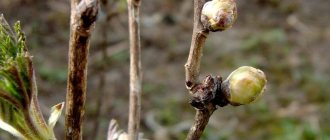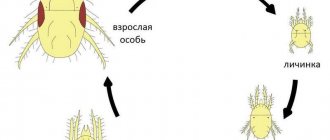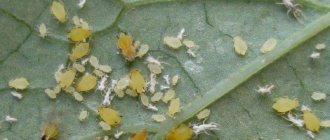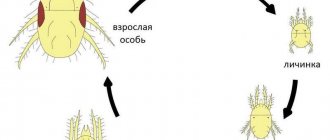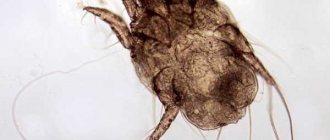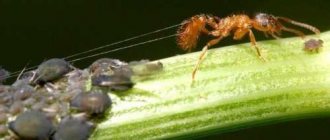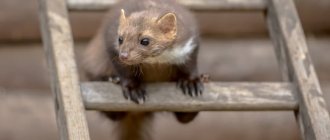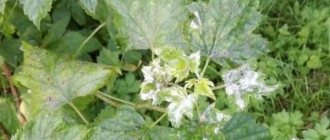Currant (currant) bud mite is the most dangerous pest of black currants. It can not only leave you without a harvest, but also cause weakening and death of plants. It is important to fight it in time and choose the right medications.
- Signs of plant damage by currant mite
- How dangerous are bud mites for plants?
- How to protect your garden from bud mites
- Measures to combat kidney mites
- Preparations against bud mites Spring treatments against bud mites
- Treatments against bud mite after harvest
Signs of plant damage by currant mite
- Winter: Some of the buds on the plant are greatly enlarged.
- Spring: Shoots develop unevenly, some are severely stunted. The leaves on them are poorly developed and deformed. Some of the round-shaped buds did not produce leaves or shoots at all. The plant blooms poorly, there are few flower clusters.
- Summer: Affected bushes lag behind in development. The shape of the bush is sloppy, some of the shoots are twisted and underdeveloped. There are few fruits, some of them fall off before reaching full maturity. Starting in August, some of the buds begin to enlarge and become rounded.
- Autumn: Buds on the plant vary in size. Some of them are enlarged and round in shape.
Bud mite on currants
Prevention
Simple rules help prevent the appearance of pests:
- You need to buy seedlings in specialized stores and licensed nurseries;
- do not take cuttings from infected plants;
- in autumn and spring, carry out sanitary pruning, after which treat clothes, tools, and burn cut branches;
- keep the area clean.
How dangerous are bud mites for plants?
The currant bud mite is a representative of the group of four-legged mites. All of them are smaller than 0.5 mm, and the currant one, even more so, is only 0.2 mm in length. Most four-legged ticks are very sensitive to low air humidity and high temperatures. Therefore, they live in the buds of plants and inside various formations of shoots (witches' brooms) or leaves (galls and felts), which are formed due to the activity of these parasites.
At the moment of flowering of the currant, the affected buds begin to wither, and the female mites climb to the surface. This is the only moment in their life when they are not protected by bud scales. Having left the bud, the pests look for young shoots and buds in the axils of the leaves, penetrate them and begin to feed and reproduce. At least three generations of parasites are born before autumn. The damaged kidney increases in size, swells and takes on a rounded shape. It will no longer be able to produce either full-fledged shoots or leaves.
Moreover, this type of mite actively carries various diseases that weaken currants, including the notorious mycoplasma, which causes double currant flowers. Bushes oppressed and weakened by mites are actively affected by stem pests: small species of longhorned beetles, borers, glass beetles.
More information about the dangerous currant stem pest:
Currant glass >>>
Diseases and pests of red currant >>>.
In winter, the pest waits out the cold under the protection of bud scales. In the spring, at the first warming, ticks begin feeding and reproducing again. By the time the currants bloom, they have time to produce two more spring generations. The time of budding and flowering of currants is coming. The affected buds begin to die, the hungry parasites again leave their cozy shelter in search of young shoots and new tasty juicy buds. They can travel through the affected bush in the thousands. They are carried from plant to plant by the wind, insects, birds, as well as people on their hands, tools and clothes. The more mites on the currant, the more buds will not wake up next spring.
bud mite on currants in summer
If you do not fight the pest, the plant will die!
How to plant and care for black currants >>>.
How to properly plant and care for red currants >>>.
What to feed blackcurrants and when >>>.
Description of the pest
The kidney (currant) mite differs from other species in a different number of limbs, it has 6, while most other individuals have 8.
This parasite belongs to the gall superfamily, the order Thrombodiformes. The body length of a male varies in the range of 0.03-1.0 cm, in females - 0.05-3.0 cm. The pest feeds on the plant sap of cultivated plants and causes enormous damage to fruit and berry plantings.
Expert opinion
Mityuk Stefania Bogdanovna
Some species of mites are beneficial saprophages. They feed on soil organic matter. This contributes to the rapid decomposition of the soil to the state of humus, improving its composition.
Kidney mite species are pests. Moreover, even a slight presence of parasites in a garden plot can provoke an epiphytotic (mass) outbreak of reproduction, which leads to the rapid death of crops.
The number of parasites in the kidney can reach more than 100 individuals, which makes this species one of the most active. The body of mites is covered with tiny bristles and is divided into the abdomen and cephalothorax.
Measures to combat kidney mites
Measures to combat currant bud mite are approximately the same as for any pest of fruit bushes. Every fall, after the leaves have fallen, inspect and identify affected bushes. If the characteristic enlargement (swelling) of the buds is sporadic, simply remove the affected buds or cut off part of the shoot with a clean pruning shears. For more severe damage, remove entire branches. In case of severe infection, you need to rejuvenate the bush by cutting off all branches almost to ground level. Or think about destroying it and replacing it with varietal currants that are resistant to damage by this pest.
How to properly prune black currants >>>.
But simply removing buds and shoots is not enough to fight mites on currants. By removing buds and shoots, you will only reduce the number of parasites on the plant, but there will still be enough of them to oppress the plants in the future. On the affected plant, the mite is present in almost every bud. Only those where from several hundred to several thousand mites have accumulated become enlarged and become spherical. It is necessary to treat the affected plants with special preparations against the currant bud mite.
Medicines against bud mites: how to treat currants?
The best time to process currants is before the currants bloom at the stage of peduncle extension. Then the migration of mites from the old affected buds to the young shoots begins. At this moment they are most vulnerable. It is at this time that non-systemic drugs can help. Ticks are not insects! Insecticides have no effect on them. Acaricides or insectoacaricides are required. To treat currants against bud mite in household plots, it is most appropriate to use low-toxic drugs containing colloidal sulfur. Please note that gooseberries are more sensitive to sulfur preparations and will get burns if the emulsion gets on them.
Spring treatments for bud mites
In the spring, you can use modern hormonal acaricidal drugs. They are not as toxic to warm-blooded animals as traditional organophosphates. Nissoran, Oberon, Judo, Forbid 4F, Envidor, Movento, Kontos perform well in the fight against ticks. Since the migration of ticks takes at least a month, and these drugs do not have a strong systemic effect, at least two treatments are required with an interval of 10–12 days.
Treatments against bud mites after harvest
More toxic organophosphorus systemic acaricides can be used only after harvest (Bi-58, Phosfamide, Famidofos, Rogor-S, Dimetrin, Accent, Pilarmax, Danadim).
Farms that are engaged in the propagation of currants, where they do not harvest, use systemic organophosphorus based on dimethoate (Bi-58, Phosfamide, Famidofos, Rogor-S, Dimetrin, Accent, Pilarmax, Danadim), as well as a powerful systemic preparation Marshal 250 CE, which , alas, has extremely toxic decomposition products.
Note!
Old sources recommend that with the arrival of spring, before the buds open, treat the plants and soil with a Nitrafen solution (300 g per 10 liters of water). But it is toxic , does not decompose easily and can accumulate in the soil, and therefore is now prohibited for use. So to combat the currant mite, you need to chemically treat the currants at a different time and with other drugs.
Currant varieties resistant to bud mite
If you are tired of the eternal battle with the currant bud mite, you should think about replacing the currant varieties you grow with ones that are resistant or relatively resistant to this pest: Irmen, Pamyati Michurin, Early Potapenko, Pamyati Potapenko, Shalunya, Sevchanka, Nightingale Night, Belorusskaya sweet, Leningradskaya sweet, Riddle, Kipiana, Leningrad giant, Nara, Oryol serenade, Otradnaya, Chernysh, Black pearl, Vigorous.
Currant varieties with complex resistance >>>.
There are many varieties of black currants of Russian, Belarusian, and Polish selection on sale. You just need to find out which of them are zoned specifically for your region. However, as the bush ages, the resistance of currants to damage by bud mites decreases.
How to deal with currant pests without chemicals >>>.
Protect the environment
The fight against bud mites causes big problems for gardeners. However, proper care of currants and implementation of preventive measures can significantly reduce the possibility of crop loss. Most measures can protect crops from mites, harmful insects, and various diseases.
Do not forget that nature itself has invented a way to get rid of pests.
In the surrounding world, each parasite has its own natural enemies, entomophages, which successfully reduce its number. It is necessary to be attentive to small workers in gardens and vegetable gardens and to use chemicals carefully.
Insects that help fight mites are ladybirds, lacewings, carnivorous bugs, parasites (chalcids), hoverflies, encarsia wasps, phytoseiulus (predatory mites), etc.
